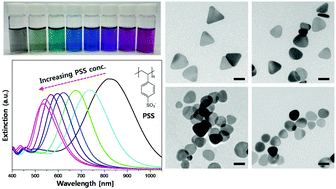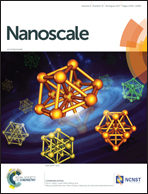A systematic study of triangular silver nanoplates: one-pot green synthesis, chemical stability, and sensing application†
Abstract
While there has been remarkable success in generating silver (Ag) nanoplates, and they have considerable potential applications, their degradation behavior in certain environments remains poorly understood. In the current work, we investigated the chemical stability of triangular Ag nanoplates. A one-step water-based synthesis method regulated by the coordination of ligands to Ag cations was successfully employed to produce triangular Ag nanoplates with a high yield. The Ag nanoplates were irreversibly degraded when they were aged with poly(styrene-4-sulfonate) (PSS) at room temperature, and the corresponding localized surface plasmon resonances (LSPR) of the Ag nanoplates changed as well. In contrast, when the Ag nanoplates were aged with potassium persulfate (KPS), the shape evolution of Ag nanoplates was found to depend on the external temperature, and the Ag nanoplate solutions showed different final colors when different external temperatures were applied. These results exhibit important implications for the behavior of triangular Ag nanoplates in a wide variety of plasmonic applications and can be applied to the colorimetric sensing of the temperature history.



 Please wait while we load your content...
Please wait while we load your content...